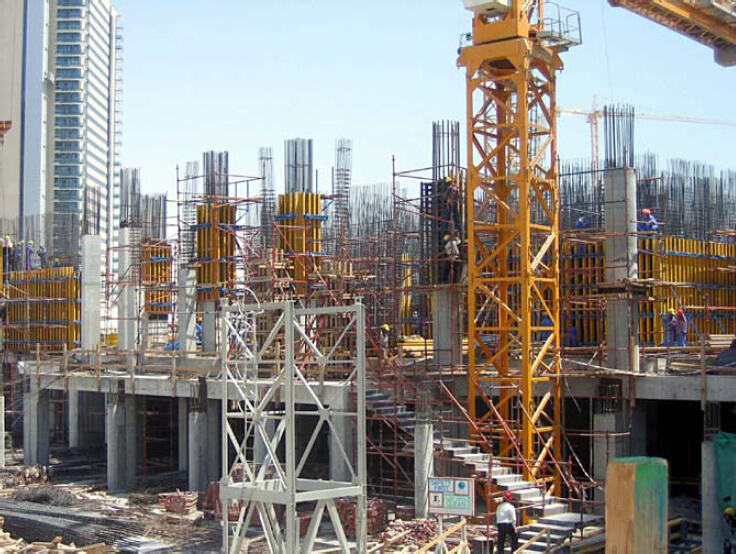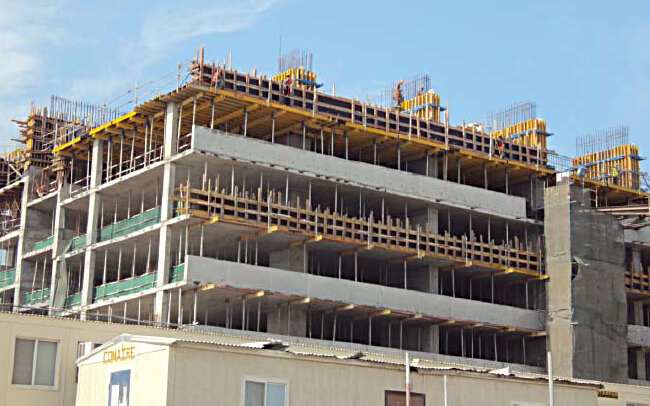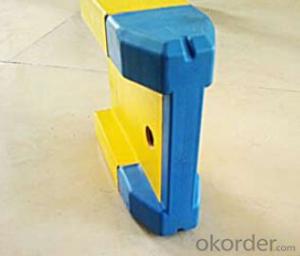Timberbeam Formwork for building Construction
- Loading Port:
- Tianjin
- Payment Terms:
- TT OR LC
- Min Order Qty:
- 50 m²
- Supply Capability:
- 1000 m²/month
OKorder Service Pledge
Quality Product, Order Online Tracking, Timely Delivery
OKorder Financial Service
Credit Rating, Credit Services, Credit Purchasing
You Might Also Like
Characteristics:
◆ Standardized production lines.
Supply capability: 3000m/day, Lmax = 6600mm.
◆ Finger jointing of the flange and web, the strength of timber beam is highly improved.
Max. shearing force failure load:40KN
◆ Well treated to prevent from water penetration or erosion, so the service life maximally
extended.
Normally, CNBM timber beam H20 can be used for 4 to 5 years, the exact using time would
depend on maintenance & storage.
◆ Robust caps at the end of the girders protect against damages.


- Q:What are the common safety training requirements for steel formwork installation?
- To ensure worker safety and project success, steel formwork installation requires adherence to various safety training requirements. These requirements may differ based on local regulations and company policies. However, some common safety training requirements for steel formwork installation are as follows: 1. Comprehensive Construction Safety Training: Workers involved in steel formwork installation must undergo general construction safety training. This training covers topics like hazard identification, proper use of personal protective equipment (PPE), emergency procedures, and safe work practices. It equips workers with a basic understanding of construction site safety. 2. Fall Protection Training: Given the elevated nature of steel formwork installation, fall protection training is crucial. Workers must be trained on the appropriate use and inspection of fall protection equipment, such as harnesses, lanyards, and anchor points. They should also learn how to set up and dismantle temporary fall protection systems like guardrails and safety nets. 3. Training for Material Handling and Lifting: Steel formwork components can be heavy and require proper lifting techniques to prevent injuries. Workers should receive training on safe lifting practices, including correct body mechanics, proper use of lifting equipment like cranes or forklifts, and an understanding of load capacities. 4. Scaffold Safety Training: Scaffold usage is common in steel formwork installation to access higher areas. Workers should be trained on safe scaffold erection, inspection, and usage. This includes knowledge of scaffold components, stability, fall protection while on scaffolds, and safe work practices. 5. Electrical Safety Training: Steel formwork installation may involve working near electrical systems or equipment. Workers should receive training on electrical safety, including identifying electrical hazards, implementing lockout/tagout procedures, and maintaining safe distances from power lines. 6. Hazard Communication Training: Workers should undergo training on hazard communication protocols, including the identification and comprehension of safety data sheets (SDS) and proper handling of hazardous materials commonly used in steel formwork installation. 7. First Aid and CPR Training: In the event of an accident or injury on the job site, workers should be trained in basic first aid and cardiopulmonary resuscitation (CPR) techniques. This training enables workers to stabilize injured individuals until professional medical assistance arrives. Employers must ensure that all workers receive comprehensive safety training prior to beginning steel formwork installation. Regular refresher courses and ongoing safety awareness programs should also be conducted to reinforce safe work practices and maintain a high level of job site safety.
- Q:PVC building template introduction
- VC building templatesPVC building template is also called wood plastic formwork, plastic formwork, plastic formwork. PVC building template is an energy-saving and environment-friendly products, after the wooden template, composite steel formwork, bamboo plywood, all steel template and a new type of product.
- Q:How does steel formwork prevent concrete segregation during pouring?
- To prevent concrete segregation during pouring, steel formwork offers a rigid and stable structure that securely holds the concrete in place. The steel panels are engineered to possess strength and durability, guaranteeing that they maintain their shape and do not bend or flex under the weight and pressure of the concrete. This effectively prevents the concrete from separating and segregating, an issue that arises when the formwork lacks sturdiness. Moreover, steel formwork is designed with tight connections and joints, effectively reducing the chances of any leakage. This is crucial because if water from the concrete mixture leaks out, it can lead to the separation and settling of aggregates, causing segregation. Therefore, the tight connections and joints contribute to maintaining the desired shape and dimensions of the concrete structure. Additionally, steel formwork is often treated or coated to prevent any chemical reactions between the concrete and the steel. This is of utmost importance as such reactions can result in concrete segregation and gradual weakening over time. Through the provision of a strong and stable framework, prevention of leakage, and avoidance of chemical reactions, steel formwork ensures that the concrete mixture remains homogeneous and properly integrated, effectively preventing segregation during pouring.
- Q:Can steel formwork be used for precast concrete wall panels?
- Yes, steel formwork can be used for precast concrete wall panels. Steel formwork offers several advantages for precast concrete construction. It provides high strength, durability, and dimensional accuracy, ensuring that the wall panels are of high quality. Steel formwork can easily be reused multiple times, making it a cost-effective option. It also allows for quick and efficient installation, reducing construction time. The flexibility of steel formwork enables the creation of various shapes and sizes of wall panels, meeting the design requirements of different projects. Overall, steel formwork is a suitable choice for precast concrete wall panels, offering numerous benefits in terms of strength, durability, efficiency, and cost-effectiveness.
- Q:How does steel formwork help in achieving accurate dimensions and shapes?
- Steel formwork helps in achieving accurate dimensions and shapes by providing a rigid and stable structure that can withstand the pressure of the concrete during the pouring and curing process. Unlike traditional wooden formwork, steel formwork does not warp or bend, ensuring that the dimensions and shapes remain consistent throughout the construction process. The steel panels used in formwork are precision-manufactured, allowing for tight tolerances and accurate measurements. These panels can be easily adjusted and interconnected, allowing for flexibility in creating various shapes and sizes. Additionally, steel formwork is highly durable and can be reused multiple times, ensuring that the dimensions and shapes achieved in one project can be replicated accurately in subsequent projects. This reusability not only saves time and money but also ensures consistent results. The strength and stability of steel formwork also prevent any deformation or movement of the concrete during the pouring and curing stages. This eliminates the risk of inaccuracies or distortions in the final dimensions and shapes of the concrete elements. Overall, steel formwork provides a reliable and efficient solution for achieving accurate dimensions and shapes in construction projects. Its strength, durability, and precision make it an ideal choice for ensuring consistent and high-quality results.
- Q:How does steel formwork affect the schedule of concrete pouring?
- Steel formwork can have a significant impact on the schedule of concrete pouring. One of the major advantages of using steel formwork is its strength and durability, which allows for faster construction progress. Unlike traditional wooden formwork, steel formwork can be reused multiple times, leading to shorter construction cycles and faster completion times. The use of steel formwork also allows for a faster assembly and disassembly process. It requires less time to set up compared to wooden formwork, as it typically comes prefabricated or in standard sizes that can be easily assembled on site. This quick assembly process reduces the time needed for formwork installation, enabling concrete pouring to begin sooner. Additionally, steel formwork provides a smooth and uniform surface finish to the concrete. It eliminates the need for plastering or additional finishing work, saving time and effort. The smooth surface also reduces the curing time required for the concrete, as it allows for more efficient evaporation of moisture. Moreover, steel formwork is known for its superior strength and stability. This allows for a higher rate of concrete pouring, as it can withstand the pressure exerted by the wet concrete without deforming or collapsing. With steel formwork, larger concrete sections can be poured at once, reducing the number of pours required and consequently saving time. However, it is important to note that steel formwork requires careful planning and coordination to ensure a seamless workflow. The availability of steel formwork materials and equipment, as well as skilled labor, must be considered during the project scheduling process. Any delays in the procurement or fabrication of steel formwork can impact the concrete pouring schedule. In conclusion, steel formwork positively affects the schedule of concrete pouring by reducing construction time, providing a smooth surface finish, allowing for faster assembly and disassembly, and enabling larger concrete sections to be poured at once. However, proper planning and coordination are essential to maximize the benefits of steel formwork and avoid any potential delays.
- Q:Can steel formwork be used for both monolithic and composite structures?
- Indeed, steel formwork is applicable to both monolithic and composite structures. This option is known for its versatility and durability, enabling it to endure the pressures and forces associated with these two types of constructions. For monolithic structures, wherein concrete is poured continuously, steel formwork plays a crucial role in providing the necessary support and containment for the fresh concrete. Its easy assembly and disassembly facilitate the efficient construction of monolithic structures like walls, slabs, and columns. The robustness and rigidity of steel formwork ensure its ability to withstand the weight and pressure of the concrete during pouring and curing. On the other hand, composite structures involve combining various materials, such as steel and concrete, to create a more efficient and sturdy structure. In this case, steel formwork can be employed to provide support for the concrete component while accommodating other materials like steel beams or columns. The adaptability of steel formwork allows for the integration of different materials, making it suitable for constructing composite structures like bridges, high-rise buildings, and industrial facilities. In both scenarios, steel formwork offers several advantages compared to other formwork materials. Its strength and durability guarantee the ability to withstand the pressures and forces exerted during construction, thereby resulting in a safer and more efficient building process. Moreover, steel formwork can be reused multiple times, reducing construction costs and minimizing waste. All in all, steel formwork is a reliable and versatile choice for both monolithic and composite structures.
- Q:What are the advantages and disadvantages of the application of the steel formwork and the plywood formwork in the construction?
- According to the area of the project, such as the number of layers to determine the type of templateFrom the perspective of saving wood, the state generally encourage the use of steel formwork
- Q:How does steel formwork contribute to the overall stability of the structure?
- Steel formwork contributes to the overall stability of a structure in several ways. Firstly, steel is a highly durable and strong material, making it capable of withstanding significant loads and pressures. This strength ensures that the formwork remains intact and stable during the construction process, even when exposed to heavy loads such as wet concrete. Secondly, steel formwork provides excellent dimensional stability. Unlike other materials like wood, steel does not warp or deform over time, ensuring that the structure maintains its desired shape and dimensions. This is crucial for the stability of the structure, as any deformation or movement in the formwork could lead to inaccuracies or weaknesses in the final construction. Moreover, steel formwork offers a high level of rigidity and stiffness. This rigidity helps to prevent any unwanted movement or shifting of the formwork during concrete pouring and curing, ensuring that the structure is built according to the intended design and specifications. It also helps distribute the weight and forces evenly, reducing the risk of structural failures or collapses. Additionally, steel formwork provides excellent support and reinforcement for the concrete. The steel panels and beams used in formwork act as a framework, holding the concrete in place until it hardens and gains its own strength. This support not only ensures the proper formation of the structure but also enhances its overall stability by preventing any concrete cracking or failure. Lastly, steel formwork is highly adaptable and can be easily customized to fit various architectural designs and construction requirements. This flexibility allows for the creation of complex and unique structures, while still maintaining stability and strength. In conclusion, steel formwork contributes significantly to the overall stability of a structure through its durability, dimensional stability, rigidity, support, and adaptability. Its robustness and ability to withstand heavy loads, combined with its ability to maintain shape and provide structural support, make it an essential component in ensuring the stability and integrity of any construction project.
- Q:How do steel formwork systems ensure proper alignment and stability?
- Steel formwork systems ensure proper alignment and stability through various features and design elements. Firstly, steel formwork systems are made of high-quality steel materials that offer excellent strength and durability. This ensures that the formwork maintains its shape and structure even under heavy loads and adverse weather conditions. Additionally, steel formwork systems often incorporate interlocking mechanisms and connecting devices that securely hold the formwork panels together. These connections provide a tight and precise alignment, ensuring that the formwork maintains its shape and prevents any movement or shifting during the concrete pouring process. Furthermore, steel formwork systems are typically designed with adjustable components, such as adjustable struts or props, which allow for easy and accurate leveling and alignment. These adjustable elements enable workers to fine-tune the formwork to the desired position and ensure a level and uniform concrete surface. Moreover, steel formwork systems often include diagonal bracing or cross-bracing elements that provide added stability and rigidity. These bracing elements help distribute the load evenly across the formwork, minimizing any potential sagging or deformation and ensuring the stability of the structure during the concrete pouring and curing process. Lastly, steel formwork systems are versatile and can be customized to fit various shapes and sizes. This flexibility allows for precise alignment to the desired form, ensuring that the concrete structure is constructed with the utmost accuracy and stability. In conclusion, steel formwork systems ensure proper alignment and stability through the use of high-quality materials, interlocking mechanisms, adjustable components, bracing elements, and customization options. These features work together to create a reliable and robust formwork system that guarantees the accurate and stable construction of concrete structures.
1. Manufacturer Overview |
|
|---|---|
| Location | |
| Year Established | |
| Annual Output Value | |
| Main Markets | |
| Company Certifications | |
2. Manufacturer Certificates |
|
|---|---|
| a) Certification Name | |
| Range | |
| Reference | |
| Validity Period | |
3. Manufacturer Capability |
|
|---|---|
| a)Trade Capacity | |
| Nearest Port | |
| Export Percentage | |
| No.of Employees in Trade Department | |
| Language Spoken: | |
| b)Factory Information | |
| Factory Size: | |
| No. of Production Lines | |
| Contract Manufacturing | |
| Product Price Range | |
Send your message to us
Timberbeam Formwork for building Construction
- Loading Port:
- Tianjin
- Payment Terms:
- TT OR LC
- Min Order Qty:
- 50 m²
- Supply Capability:
- 1000 m²/month
OKorder Service Pledge
Quality Product, Order Online Tracking, Timely Delivery
OKorder Financial Service
Credit Rating, Credit Services, Credit Purchasing
Similar products
New products
Hot products
























